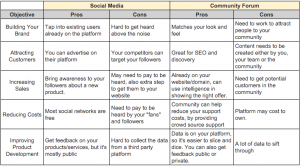— March 27, 2019
When starting a new business, there’s a lot to tackle: Building a product or service, endless paperwork, hiring a great team, and finding customers or clients.
Regardless of the size of a new organization, leaders can get lost in those critical tasks and neglect the steps it takes to succeed with digital marketing in the future. Don’t forget these six important steps (yes, we know #3 is a big one) when you’re launching your business.

1. Create a business recovery email
When signing up for new tools, accounts, and services, you’ll want to have one central point for communications, billing and updates. Sign up for a Gmail account, and make sure the owner and manager have access and use it only for those purposes.
This account is not to be used for communicating, conducting business, or handling business payments — it is meant as an operational account.
Keeping everything important connected with one email address saves a lot of time and frustration in the future when people can’t remember what email they used to signup for which service. Our clients often struggle to get access to accounts that were set up by someone who no longer works with them. Avoid that by using your recovery account to manage access, get billing statements, get password resets for the online services and tools you use.
2. Purchase a website domain for your business
The first step to building any business–online or not–is to find a unique and memorable domain name. Using a service like GoDaddy, Google Domains, or Name.com, you can reserve a domain name, usually for around $ 20 a year. Don’t buy website hosting at this point; let the web development team you hire choose that for you. You’ll get the best value with them if you use the services with which they’re most familiar, and they’ve probably done their homework.
An ideal domain name should be the name of your business, perhaps with the thing you do or sell added if you need to (and at this point, you’ll need to). Try to avoid acronyms, abbreviations, or using a city or region if you ever plan to grow. (We mistakenly thought we’d be a “design” agency forever; thus, our original domain and where our emails are hosted is “BigSeaDesign.com.” Now that we’re a marketing agency with design as a service, we regret that decision.)
3. Get a solid iteration of your website published
Don’t skip this step. Whether you hire an agency, use a website builder (we recommend Squarespace, if you’re wondering), or decide to write the HTML by hand, prioritize publishing a simple website as quickly as possible. It doesn’t have to be robust in its first iteration, but it should clearly communicate what you offer. Plan to grow your website to the point that it educates visitors on what you sell, how to evaluate your product, and why (and how) to buy it.
Ideally, your website should make it easy for prospective leads to contact you or sign up for your service by building landing pages, capture forms, or email pop-ups. Focus on creating a welcoming, educational experience, so that visitors understand what you do, and feel comfortable doing business with you. Make sure your address and a way to get in touch are immediately available.
4. Set up Search Console
Search Console is your way to communicate directly with Google about your site. You can submit the site for inclusion into the search index, and gain valuable information on how your site is performing in search, along with lists of issues and errors to correct for even better performance.
With Search Console, you can see directly how many times your site has been seen and clicked in search, what keywords people use to find your site, and what websites link to your page. You can also get information as to any errors on the site, any penalties your site has gotten, and any other issues which could affect the delivery of your site.
Setting us Search Console is easy and straightforward — just add a small code snippet to the <head> section of your homepage, or add an HTML file to your home directory and click verify. That’s it! Here’s a great blog post on setting up and getting the most out of Search Console.
5. Set up Google Analytics
Google Analytics gives you insights on how people are interacting with your website, which pages are the most engaged, and where people drop off or leave your site. Analytics can also track the results of marketing campaigns, can show you how people find your website, and how people interact with the content on the site. Best of all, it’s completely free!
But what makes Google Analytics a must-have tool is the conversion tracking. A conversion is when someone performs a business-related action on the site—whether it’s submitting a form, making a purchase, requesting a consultation, downloading a guide, or whatever action has a business result tied to it. By tracking conversions, you can get better insights as to which actions, campaigns, or ads are generating actual business on your site, so that you can make better business decisions.
Setting up Google Analytics can be tricky for first-timers. Use a step-by-step guide to set up Google Analytics on your site.
Try this tutorial for setting up conversion tracking to get the most out of Google Analytics.
6. Set up local listings
Local Listings are incredibly useful for finding a business online, whether you serve people at your location, in a radius from your office, or at the customer’s home. If you interact solely online, a local listing carries useful contact information for customers to learn more about your offerings and contact you if needed. You can encourage happy customers to leave reviews on your listings, which can help others who might be trying to decide on which business to contact.
The 3 major Search Engines (Google, Yahoo, and Bing) each offer a portal for you to manage your local listings on their platforms directly. Always build your local listing out completely by adding the business name, hours of operation, images of the storefront, phone number and address, and other pertinent details that could help prospective customers reach you easier. The more information, the better.
For more information on the value of local listings for small businesses, check out the Big Sea guide to local listings.
Don’t skip ahead
While the six steps we’ve outlined might sound straightforward, you’d be surprised to find that many entrepreneurs skip some of these steps when starting their first (or fifth company). We’ve seen the aftermath.
View this guide as creating an online foundation for your business. Skipping any of these steps can lead to missing or inaccurate information, inaccessible accounts, bad data, or lack of visibility online. They are integral in supporting the rest of your efforts.
Business & Finance Articles on Business 2 Community
(33)
Report Post








